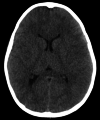Acute Fulminant Cerebral Edema in a Child With Suspected Meningoencephalitis
- PMID: 37849589
- PMCID: PMC10577669
- DOI: 10.7759/cureus.45339
Acute Fulminant Cerebral Edema in a Child With Suspected Meningoencephalitis
Abstract
Acute fulminant cerebral edema (AFCE) is a recently identified encephalitis type associated with significant morbimortality. Described as rare, limited data exists on its early detection and treatment. This paper describes a case of AFCE that progressed to unresponsive intracranial hypertension. A previously healthy four-year-old boy presented with fever, myalgias, and neurological symptoms. Diagnostic assessments showed cerebrospinal fluid abnormalities, and despite medical interventions, his condition deteriorated rapidly and developed severe cerebral edema and herniation within 24 hours. A decompressive craniectomy was attempted to decrease intracranial pressure, without success. This case emphasizes the urgency of early AFCE recognition and effective management strategies given its severe prognosis, aiming to improve understanding and spur further research.
Keywords: acute encephalitis; acute fulminant cerebral edema; decompressive craniectomy; hyperosmolar therapy; secondary intracranial hypertension.
Copyright © 2023, Monteiro et al.
Conflict of interest statement
The authors have declared that no competing interests exist.
Figures



References
-
- Acute fulminant cerebral edema: a newly recognized phenotype in children with suspected encephalitis. Krishnan P, Glenn OA, Samuel MC, et al. J Pediatric Infect Dis Soc. 2021;10:289–294. - PubMed
-
- Analysis of fulminant cerebral edema in acute pediatric encephalitis. Lan SY, Lin JJ, Hsia SH, Wang HS, Chiu CH, Lin KL. Pediatr Neonatol. 2016;57:402–407. - PubMed
-
- Craniectomy: an aggressive treatment approach in severe encephalitis. Schwab S, Jünger E, Spranger M, Dörfler A, Albert F, Steiner HH, Hacke W. Neurology. 1997;48:412–417. - PubMed
-
- Raised intracranial pressure in acute viral encephalitis. Kumar G, Kalita J, Misra UK. Clin Neurol Neurosurg. 2009;111:399–406. - PubMed
Publication types
LinkOut - more resources
Full Text Sources
